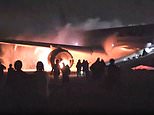
Children were heard screaming and pleading for their lives as bright flames licked the exterior of the Japan Airlines plane that smashed into a coastguard aircraft on the runway of Haneda Airport yesterday.
But the crew of JAL flight 516, an Airbus A-350 carrying 367 passengers that turned into a fireball upon collision, had to stay level-headed and collected, in order to save as many lives as possible.
Their exemplary work in saving every single person onboard has astounded the world, and experts have praised the crew for calmly using their rigorous training to save hundreds of lives.
But experts also commended passengers for being ‘well behaved’ in the face of pure terror.
‘I don’t see a single passenger on the ground, in any of the videos I’ve seen, that has got their luggage with them,’ Professor Ed Galea, director of the Fire Safety Engineering Group at the University of Greenwich, told the BBC.
Children onboard are heard shouting as flames engulf the aircraft on the outside
Video footage of the crash shows that passengers hurled themselves down the slide with little fuss, ensuring that everyone got off quickly
All 379 passengers miraculously escaped from the Japan Airlines plane after they were safely evacuated
Tokyo Metropolitan Police investigators inspect the area around the Japan Coast Guard aircraft that collided with a Japan Airlines passenger plane at Haneda Airport
‘If people tried to take their cabin luggage, that’s really dangerous because they would slow down the evacuation.’
The inferno quickly engulfed the plane, making evacuation extremely difficult.
Only three of the inflatable slides could be used, but even these weren’t deployed properly due to the plane’s nose collapsing.
But video footage of the crash shows that passengers hurled themselves down the slide with little fuss, ensuring that everyone got off quickly.
The crew were also forced to use a megaphone to calmly, but clearly communicated instructions to terrified passengers, after the built-in tannoy system broke in the fire.
Video shows two crew members trying to get the tannoy system working again, as children wail and plead for their lives.
Several current and former airline industry experts told the BBC that Japan Airlines’ stringent training measures helped save lives on Tuesday.
Terrifying footage from inside the plane shows how passengers covered their faces and struggled to breathe as the cabin filled with smoke following the fire
This aerial photo show the burn-out Japan Airlines plane at Haneda airport
New crew members are said to go through evacuation and rescue training for up to three weeks before they were allowed to serve commercial flights.
This training is repeated once a year to ensure it stays fresh in crew members’ minds.
‘We go through a written exam, case study discussions and practical training using different scenarios, such as when the plane has to make a water landing or if there is fire on board. Maintenance staff are also involved in such training,’ said a former flight attendant, who left the company ten years ago, and spoke on the condition of anonymity.
Today, in order for any passenger aircraft to be internationally certified, aeroplane makers have to prove that it is possible for everyone to leave a plane within 90 seconds, with tests sometimes involving actual passengers.
Flying accidents have often been one of the primary drivers in innovations in safety technology and procedures.
A Japan Airlines plane sits on fire after it collided with a Coast Guard aircraft on the ground at Tokyo’s Haneda airport
The plane was consumed by fire shortly after the crash
Haneda Airport was shut down almost immediately after the incident
A 1985 crash involving a Japan Airlines plane that killed 520 people. To date, it is the deadliest single-aircraft accident in history.
The crash woke Japan’s airline industry up, and Japan Airlines in particular wanted to make sure that nothing like this ever happened again.
In 2005, the company realised that many were joining without even being alive to remember the deadly crash, and so the following year it opened a museum near Haneda Airport displaying wreckage from the incident, with an aim to remind its employees of the deadly consequences of doing a bad job.
‘In face of the pain and grief of the bereaved families and public distrust in airline safety [after the 1985 crash], we pledged that we would never again allow such a tragic accident to occur,’ Japan Airlines wrote on the facility’s webpage.
‘Every staff is reminded that valuable lives and property are entrusted to us in our work.’
Source link
CHECK OUT: Top Travel Destinations
READ MORE: Travel News



